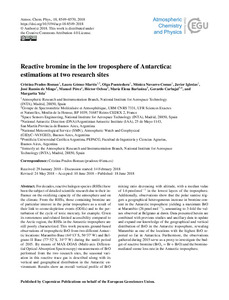Por favor, use este identificador para citar o enlazar este ítem:
https://repositorio.uca.edu.ar/handle/123456789/9518| Título: | Reactive bromine in the low troposphere of Antarctica : estimations at two research sites | Autor: | Prados Roman, Cristina Gómez Martín, Laura Puentedura, Olga Navarro Comas, Mónica Iglesias, Javier De Mingo, José Ramón Pérez, Manuel Ochoa, Héctor Barlasina, María Helena Carbajal, Gerardo Yela, Margarita |
Palabras clave: | BROMO; TROPOSFERA; ANTARTIDA | Fecha de publicación: | 2018 | Editorial: | European Geosciences Union | Cita: | Prados Roman, C. et. al. Reactive bromine in the low troposphere of Antarctica : estimations at two research sites [en línea]. Atmospheric Chemistry and Physics. 2018, 18. doi:10.5194/acp-18-8549-2018 Disponible en: https://repositorio.uca.edu.ar/handle/123456789/9518 | Resumen: | Abstract: For decades, reactive halogen species (RHSs) have been the subject of detailed scientific research due to their influence on the oxidizing capacity of the atmosphere and on the climate. From the RHSs, those containing bromine are of particular interest in the polar troposphere as a result of their link to ozone-depletion events (ODEs) and to the perturbation of the cycle of toxic mercury, for example. Given its remoteness and related limited accessibility compared to the Arctic region, the RHSs in the Antarctic troposphere are still poorly characterized. This work presents ground-based observations of tropospheric BrO from two different Antarctic locations: Marambio Base (64∘13′ S, 56∘37′ W) and Belgrano II Base (77∘52′ S, 34∘7′ W) during the sunlit period of 2015. By means of MAX-DOAS (Multi-axis Differential Optical Absorption Spectroscopy) measurements of BrO performed from the two research sites, the seasonal variation in this reactive trace gas is described along with its vertical and geographical distribution in the Antarctic environment. Results show an overall vertical profile of BrO mixing ratio decreasing with altitude, with a median value of 1.6 pmol mol−1 in the lowest layers of the troposphere. Additionally, observations show that the polar sunrise triggers a geographical heterogeneous increase in bromine content in the Antarctic troposphere yielding a maximum BrO at Marambio (26 pmol mol−1), amounting to 3-fold the values observed at Belgrano at dawn. Data presented herein are combined with previous studies and ancillary data to update and expand our knowledge of the geographical and vertical distribution of BrO in the Antarctic troposphere, revealing Marambio as one of the locations with the highest BrO reported so far in Antarctica. Furthermore, the observations gathered during 2015 serve as a proxy to investigate the budget of reactive bromine (BrOx = Br + BrO) and the bromine-mediated ozone loss rate in the Antarctic troposphere. | URI: | https://repositorio.uca.edu.ar/handle/123456789/9518 | ISSN: | 1680-7316 (impreso) 1680-7324 (online) |
Disciplina: | INGENIERIA AMBIENTAL | DOI: | 10.5194/acp-18-8549-2018 | Derechos: | Acceso abierto | Fuente: | Atmospheric Chemistry and Physics. 2018, 18 |
| Aparece en las colecciones: | Artículos |
Ficheros en este ítem:
| Fichero | Descripción | Tamaño | Formato | |
|---|---|---|---|---|
| reactive-bromine-low-troposphere.pdf | 10,54 MB | Adobe PDF |  Visualizar/Abrir |
Visualizaciones de página(s)
254
comprobado en 28-nov-2025
Descarga(s)
224
comprobado en 28-nov-2025
Google ScholarTM
Ver en Google Scholar
Altmetric
Altmetric
Este ítem está sujeto a una Licencia Creative Commons

